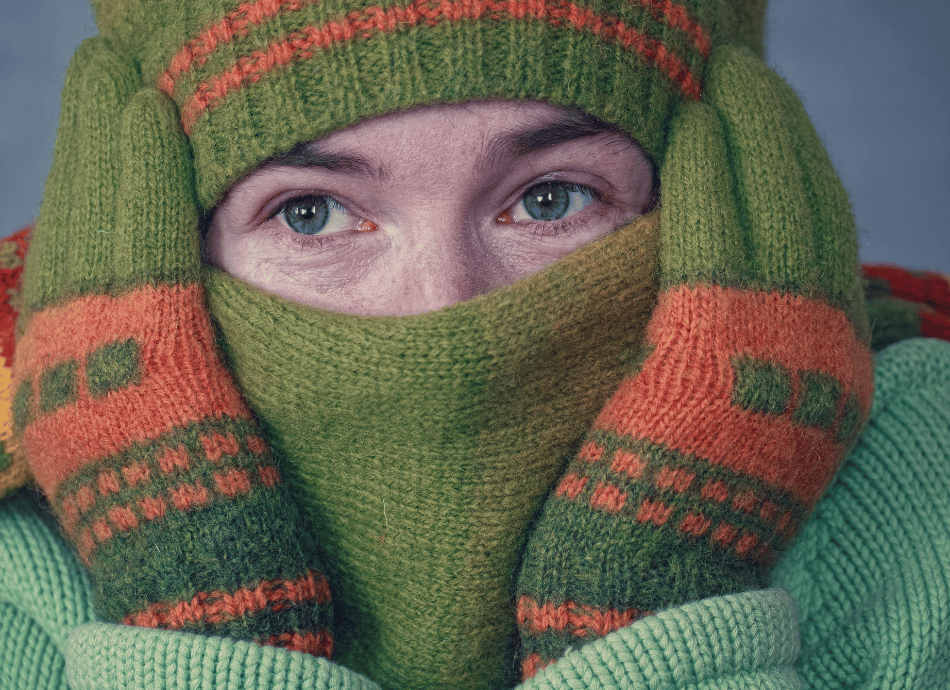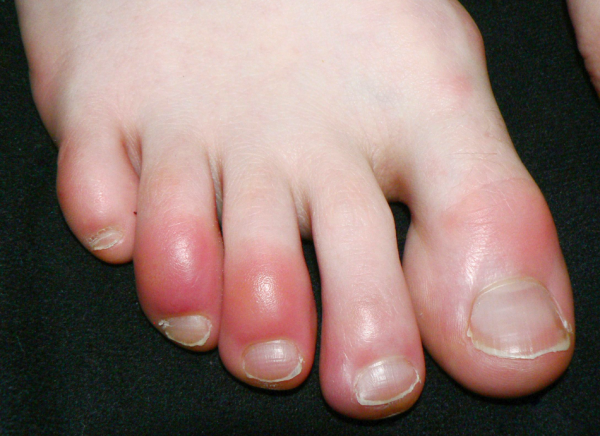Chilblains
Also called pernio or perniosis
Key points about chilblains
- Chilblains are red or purple tender or itchy patches on your skin, usually on your fingers or toes.
- They’re caused by your skin being exposed to air which is damp and cold but not freezing, most often in late winter to early spring.
- They start within hours of exposure to cold and take a few weeks to get better.
- Keeping your skin warm and dry and taking pain killers can ease the symptoms.
- They can be prevented by dressing warmly and keeping your skin covered up when you go out into the cold.

Chilblains, also called perniosis, happen when skin is exposed to cold, damp air. Swollen lumps develop that can be itchy and sore. The skin can also form blisters, but that's rare. Chilblains are most likely to happen in late winter or early spring when the air is damp and cold but not freezing.
 Image credit: Sapp Wikimedia Commons
Image credit: Sapp Wikimedia Commons
The exact cause isn’t known but it could be due to what happens when your body has got cold and then rewarms. Small blood vessels may expand more quickly than nearby larger blood vessels as they warm up again, causing them to swell and itch or hurt.
In general, chilblains are more likely to happen for young to middle aged adults, and are less commonly found in older adults and children. However, other factors can increase your risk of getting chilblains. These include:
- wearing tight clothing or shoes in cold, damp weather
- being a young woman
- having a low bodyweight or poor diet
- smoking
- living in cold damp places
- working outside and being unable to keep your skin dry and warm eg, farming and fishing
- some medical conditions, eg, bone marrow disorders, Raynaud’s phenomenon, connective tissue disorders like lupus and possibly COVID-19 (COVID toe)
- having other family members who get chilblains.
Symptoms can include your skin being:
- swollen
- red or purple in colour (this is less obvious if your skin is brown or black.)
- itchy, sore, stinging or burning
- blistered.
The patches can show up a few hours after you have exposed your hands or feet to the cold. They can also happen on your face, ears or legs.
You can be confident you have chilblains if:
- you get tender, itchy red or purple patches on your fingers or toes within a few hours of going into cold and damp air
- the patches don’t continue to get worse, and get better within a few weeks
- you’re otherwise well.
Chilblains generally get better on their own, but may return if you expose your skin to damp cold again. They may come back each year if the condition becomes chronic.
If you’re not sure, you could start by talking to your pharmacist. They can give you advice on the best painkiller to take, and creams to help soothe the itching. They can also tell you if you need to see your healthcare provider. Chilblains can generally be diagnosed from looking at the affected area and asking questions about your symptoms. If there’s any doubt about why you might have developed chilblains, you may need a blood test to rule out other conditions. Rarely, you may be prescribed a medicine to help improve your blood flow.
While you have a chilblain:
- keep the area warm and dry
- if the area gets cold, don’t rewarm it quickly but put on warm clothing and stay away from direct heat (eg, don’t use hot water bottles or heaters)
- don’t rub, massage or scratch the area
- take paracetamol or ibuprofen if your chilblains are sore and if these medicines are safe for you
- keep any blisters or sores clean and covered.
To prevent chilblains:
- Avoid getting cold and wet and, if you do, warm up slowly without using direct sources of heat.
- Wear warm, dry clothes to protect areas that may be exposed to cold conditions.
- Exercise to stay warm and increase blood circulation when you’re out in the cold.
- Stop smoking as it restricts blood flow by narrowing your blood vessels.
You will probably be able to look after your chilblains at home. However, you should see a healthcare provider if:
- your skin is broken and looks infected
- you have a high temperature or feel hot and shivery
- you’re having problems with the symptoms after 2–3 weeks
- they keep coming back
- you have diabetes.
References
Chilblains(external link) NHS, UK, 2022
Chilblains(external link) Mayo Clinic, US, 2023
Chilblains(external link) DermNet, NZ, 2021
Credits: Healthify editorial team. Healthify is brought to you by Health Navigator Charitable Trust.
Reviewed by: Dr Emma Dunning, Clinical Editor and Advisor
Last reviewed:





